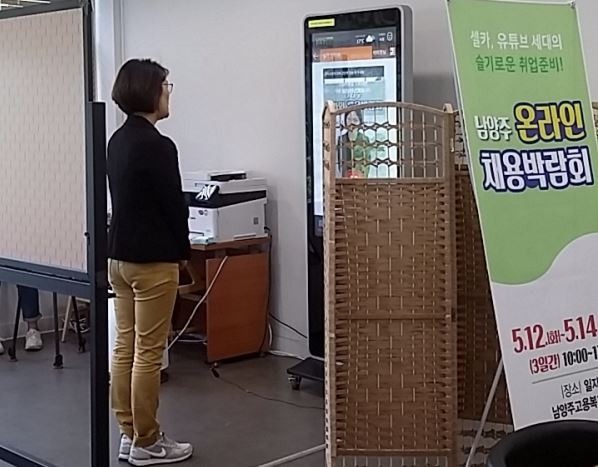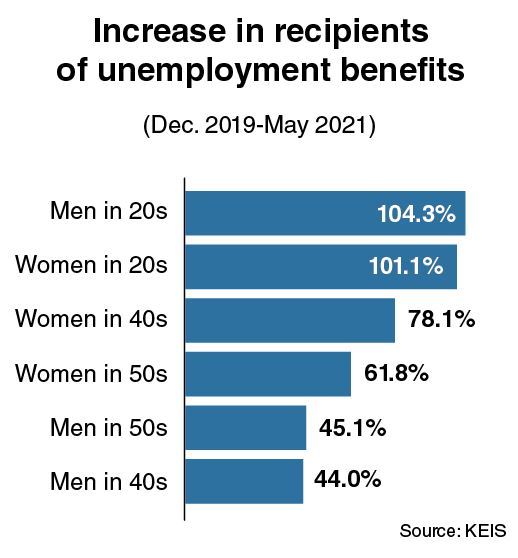 |
A woman is interviewed during an online job fair, hosted by Namyangju City Hall in Gyeonggi Province in May last year. (Namyangju City) |
SEJONG -- Data on government payouts for people who have lost their jobs indicates that men and women in their 20s in South Korea were hit hardest by the pandemic over the past 1 1/2 years.
In addition, the novel coronavirus dealt a worse blow to women than men in terms of job security, data held by the Korea Employment Information Service showed.
The monthly tally of recipients of unemployment benefits reached 712,400 in May. This marked a 67.4 percent increase from 425,390 in December 2019, a month before COVID-19 hit the nation.
There was a certain level of gender disparity: While male workers posted a 57.5 percent increase in the number of benefit recipients over the 17-month period, the figure for female workers surged by 77.3 percent.
In almost all age groups, the numbers of women on benefits grew faster than the corresponding numbers for men: 59.5 percent vs. 36.5 percent for people in their 30s; 78.1 percent vs. 44 percent for people in their 40s; 61.8 percent vs. 45.1 percent for people in their 50s; and 100.4 percent vs. 74 percent for people in their 60s.
 |
(Graphic by Kim Sun-young/The Korea Herald) |
Only among people in their 20s was the trend reversed, with the number of men on benefits growing 104.3 percent, vs. 101.1 percent for women. But figures for both groups were so high that it was clear the younger generation took the hardest hit irrespective of gender.
The number of recipients of unemployment benefits in their 20s climbed from 34,163 women and 21,051 men in December 2019 to 68,714 women and 43,014 men in May 2021.
“It is estimated that young nonregular employees, including those working at convenience stores or coffee shops, suffered en masse layoffs from the pandemic, or businesses had to initially dismiss workers with relatively low vocational skills,” said a labor researcher in Seoul.
The pandemic turned more and more Koreans into “discouraged workers,” meaning they gave up looking for work. The tally of discouraged workers counts people who have not engaged in job-seeking activities during the past four weeks, despite having looked for work within the past 12 months.
According to the data from Statistics Korea, the number of discouraged workers reached 612,000 last month. This marked an increase by 78,000 people, from 534,000 in December 2019.
Compared with four years earlier in May 2017, when the Moon Jae-in administration took office, the number of discouraged workers climbed by 22.8 percent from 498,000 people.
According to the Supplementary Index III for Employment, held by Statistics Korea, the de facto jobless rate in the nation came to 13.5 percent in May 2021, which contrasted with 11.1 percent in December 2019.
Index III shows the extended-based jobless rate, which reflects underemployment as well as unemployment. People deemed jobless under this definition include temporary employees who work fewer than 36 hours a week and want to work more hours, as well as seasonal workers who are out of work for part of the year.
The number of de facto jobless, unemployed plus underemployed, increased from 3.29 million to 4.12 million over the corresponding period.
Further, the de facto jobless rate among those aged 15-29 climbed from 20.8 percent in December 2019 to 24.3 percent in May 2021, which means 1 in 4 young Koreans are out of work in practical terms.
One analyst, citing Index III, said a large portion of young Koreans suffer from weak job security in the form of nonregular job status, meaning they are employed as contract or temporary workers.
By Kim Yon-se (
kys@heraldcorp.com)








![[Today’s K-pop] Blackpink’s Jennie, Lisa invited to Coachella as solo acts](http://res.heraldm.com/phpwas/restmb_idxmake.php?idx=644&simg=/content/image/2024/11/21/20241121050099_0.jpg)
